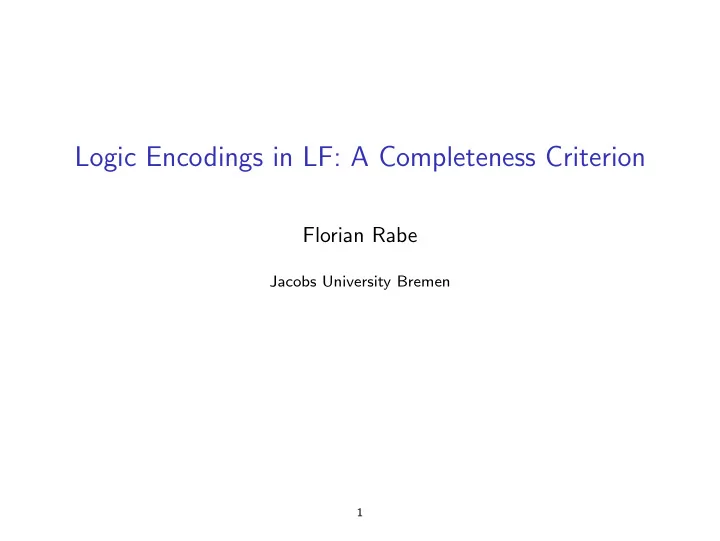

Logic Encodings in LF: A Completeness Criterion Florian Rabe Jacobs University Bremen 1
LF ◮ LF = A Framework for Defining Logics (Harper, Honsell, Plotkin; 1993) ◮ Impredicative dependent type theory, related to Martin-L¨ of type theory ◮ Curry-Howard equivalent to first-order logic with predicates, implication and universal quantifier ◮ Types: ◮ Application of type-valued constant, e.g., if Matrix : N → N → type , then Matrix (5 , 4): type ◮ Dependent product, e.g., if I : Π x : N . Matrix ( x , x ), then I (3): Matrix (3 , 3) (e.g., identity matrix) 2
Logic Encodings ◮ LF very suitable for logic encodings (esspecially natural deduction or sequent calculus) ◮ Example: Fragment of propositional logic with natural deduction form : type ∧ : form → form → form proof : form → type ∧ I : proof ( F ) → proof ( G ) → proof ( F ∧ G ) ∧ El : proof ( F ∧ G ) → proof ( F ) ∧ Er : proof ( F ∧ G ) → proof ( G ) ◮ Structural rules (axiom, weakening, exchange) naturally derivable in the type theory ◮ Model theory not covered 3
LF as a Logic ◮ Proof and model theory for LF developed building on joint work with Steve Awodey ◮ Permits to ◮ encode model theory of logics as well as proof theory ◮ formalize encodings as institution translation into LF ◮ reason about logic encodings ◮ Formulas: equalities for all types, first-order connectives, first-order quantifiers for all types, classical negation 4
Proof theory of the LF meta-logic (examples) F ⊢ Σ F ′ ⊢ Σ F ⇒ F ′ ⊢ Σ F ⊢ Σ F ⇒ F ′ ⊢ Σ F ′ ⊢ Σ F ′ ⊢ Σ F ∧ F ′ ⊢ Σ F ⊢ Σ F ∧ F ′ ⊢ Σ F ∧ F ′ ⊢ Σ F ′ ⊢ Σ F x : S ⊢ Σ F ⊢ Σ ∀ x : S . F ⊢ Σ s : S ⊢ Σ ∀ x : S . F ⊢ Σ F [ x / s ] x : S , F ⊢ Σ F ′ ⊢ Σ s : S ⊢ Σ F [ x / s ] ⊢ Σ ∃ x : S . F ∃ x : S . F ⊢ Σ F ′ 5
Example and Completeness Criterion ◮ Extending LF encodings to cover model theory surprisingly simple ◮ Example: two axioms needed in the LF meta-logic to encode first-order logic ◮ non-empty model universes: ∃ x : univ . true ◮ consistency: ¬∃ x : proof ( false ) . true ◮ Completeness criterion: All provable existential quantifiers have witnesses Question: When can this criterion be applied? 6
Recommend
More recommend